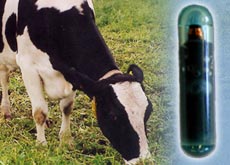Radio tracking devices set to boom

The use of an old technology to trace and track objects, animals and people looks set to flourish with falling prices in the next five years.
A Swiss company, Sokymat, says cheaper versions of radio frequency tags will lead to a huge expansion of the market.
Sokymat’s tags are already used in their millions worldwide to immobilise cars, to gain access to buildings and to track pets and livestock, including migrating salmon and racing pigeons.
They are also being used by the United States army in trials to see whether bees can seek out landmines.
The privately owned company, based in Granges near Lausanne, claims to be the biggest producer of smart tags in the world.
Smart tags
The transponders – microchips attached to antennas – are electronically programmed with unique information.
A tag made of rubber, metal or glass containing the device can then be manufactured into tyres, containers, clothing or whatever companies want to track and identify.
When the tag nears a transceiver or reader, it reveals the information contained in its chip by radio wave.
Sokymat’s company’s cheapest tags sell for about SFr0.5-SFr1. “Price is limiting the volume on the market right now,” Béat Clerc, Sokymat’s head of business development, told swissinfo.
“When we are able to reduce this price to below ten Swiss cents, it will open a lot of new markets.”
Market leader
For Sokymat, mass production of smart tags took off with car immobilising systems in the mid-1990s.
The tag, contained in the key, originally transmitted a fixed code which tallied with the one in the car.
Increasingly complicated tags are in the pipeline with future generations expected to personalise the car for drivers, adjusting seat size and tuning radio stations according to an individual’s preference.
Until January, when the Swatch Group acquired its automobile immobilising product unit in Germany, Sokymat was market leader in this field, producing about half of the 60-70 million tags manufactured annually for the car market.
Animal tracking
Livestock identification offers huge potential for tagging, with an estimated one billion cows worldwide and 450 million pigs in China alone.
Sokymat has developed three devices for the livestock industry. The first is a ceramic bolus which a vet places in the third stomach of ruminants, such as cows and sheep, where it stays for life.
However farmers prefer the normal ear tags that are used worldwide for visual identification with an electronic part built in.
“It’s not as safe,” said Clerc. “You can remove it very easily but it’s cheap and easy to put on.”
“The third possibility is a glass tag which is injected under the skin but in the slaughterhouse, people don’t have time to look for these devices so you risk this glass tag turning up in your meat.”
With livestock as with luggage, international standards are vital, says Clerc.
“We need to register luggage in Geneva and be able to read it everywhere else in the world. You need regulation and standardisation to regulate all this tracking.”
Landmine detection
The US army is putting tags to a different use. It is carrying out experiments to see whether bees tagged with microchips can detect landmines.
“The bees are attracted by TNT and some of them home in on the mines,” said Clerc. “When they returned to the hive, they land on special mats that can detect TNT and identify individual bees.
“Using the direction of a bee’s flight and its flight time, you can roughly determine where the landmine is.”
Currently, a million tags are used to detect the migration of salmon off the United States and Canada and two million tags are used annually for pigeon racing.
Barcodes
If prices come down low enough, smart tags may one day provide an alternative to barcodes, says Clerc.
“They have a number of benefits,” said Clerc. “They don’t have to be in sight or contact of the reader. They don’t become scratched and unusable and they can be reused.”
Sokymat says its current capacity is about 110-120 million tags a year.
In 2000, the company said it produced more than 50 million transponders with sales equivalent to about SFr70 million worldwide.
swissinfo, Vincent Landon
Radio frequency identification (RFID) first appeared in tracking and access applications during the 1980s.
RFID systems are made up of readers and smart tags – microchips attached to antennas.
When the tag nears a reader, it reveals the information contained in its chip.
The antenna emits radio signals to activate the tag and read and write data to it.

In compliance with the JTI standards
More: SWI swissinfo.ch certified by the Journalism Trust Initiative








You can find an overview of ongoing debates with our journalists here . Please join us!
If you want to start a conversation about a topic raised in this article or want to report factual errors, email us at english@swissinfo.ch.